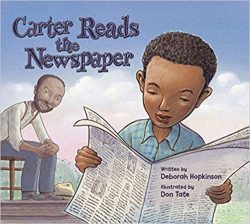
Our collection of picture books featuring Black and Indigenous people and People of Color (BIPOC) is available to the public. *Inclusion of a title in the collection DOES NOT EQUAL a recommendation.* Click here for more on book evaluation.
Find titles using a keyword search below (e.g. adoption, birthday, holidays, etc.), or by selecting one or a combination of filters on the lefthand sidebar below.
First time here? Start here!
196 matching books
Show FiltersFilter Results
-
Beautiful Life 196
-
Biography 83
-
Cross Group 17
-
Folklore 2
-
Balinese 1
-
Basotho 1
-
British 2
-
Burmese 1
-
Canadian 2
-
Chinese 9
-
Cuban 1
-
Egyptian 1
-
Ethiopian 10
-
Gambian 1
-
German 1
-
Ghanaian 2
-
Haitian 1
-
Hmong 2
-
Igbo 1
-
Indian 11
-
Iranian 2
-
Iraqi 2
-
Jamaican 2
-
Japanese 3
-
Kenyan 8
-
Kikuyu 1
-
Korean 2
-
Laotian 1
-
Mexican 15
-
Moroccan 2
-
Ndebele 1
-
Nepalese 2
-
Nigerian 3
-
Persian 1
-
Peruvian 1
-
Russian 2
-
Somali 1
-
South Asian 14
-
Sudanese 1
-
Thai 3
-
Tibetan 1
-
Ugandan 1
-
Unspecified 36
-
Zambian 1
-
Africa 33
-
Alabama 1
-
Arctic 5
-
Arizona 1
-
Arkansas 2
-
Asia 32
-
Bali 1
-
Brazil 3
-
California 11
-
Cambodia 2
-
Cameroon 1
-
Canada 19
-
China 8
-
Colombia 1
-
Cuba 1
-
Eastern Asia 12
-
Egypt 1
-
England 1
-
Ethiopia 10
-
Europe 4
-
Florida 2
-
France 2
-
Gambia 1
-
Georgia 2
-
Germany 1
-
Ghana 1
-
Greece 1
-
Haiti 2
-
Hawaii 2
-
Illinois 5
-
India 10
-
Indiana 1
-
Iran 3
-
Iraq 2
-
Jamaica 1
-
Japan 2
-
Kansas 2
-
Kenya 8
-
Laos 2
-
Malaysia 1
-
Maryland 3
-
Mexico 15
-
Mongolia 1
-
Montana 1
-
Morocco 2
-
Nepal 1
-
Nevada 1
-
New York 15
-
Nigeria 3
-
Norway 1
-
Nunavut 4
-
Oceania 3
-
Oklahoma 2
-
Pakistan 2
-
Peru 2
-
Russia 2
-
Spain 1
-
Taiwan 1
-
Texas 5
-
Thailand 5
-
Tibet 1
-
Uganda 1
-
Vietnam 2
-
Virginia 2
-
Zambia 1
-
Zimbabwe 1
-
Fiction 2
-
Non-Fiction 196
-
Boy/Man 105
-
Girl/Woman 96
-
Māhū 1
-
Unspecified 10
-
Background 11
-
Dominant Main 110
-
Joint Main 21
-
Secondary 92

Sewing stories
"Harriet Powers learned to sew and quilt as a young slave girl on a Georgia plantation. She lived through the Civil War and Reconstruction, and eventually owned a cotton farm with her family, all the while relying on her skills with the needle to clothe and feed her children. Later she began making pictorial quilts, using each square to illustrate Bible stories and local legends. She exhibited her quilts at local cotton fairs, and though she never traveled outside of Georgia, her quilts are now priceless examples of African American folk art."--Amazon.com

Brave ballerina
Janet Collins wanted to be a ballerina in the 1930s and 40s, a time when racial segregation was widespread in the United States. From her early childhood lessons to the height of her success as the first African-American prima ballerina in the Metropolitan Opera, this is the story of a remarkable pioneer. Full color

La frontera: el viaje con papa / The Border: my journey with papa
Join a young boy and his father on an arduous journey from Mexico to the United States in the 1980s to find a new life. They’ll need all the courage they can muster to safely cross the border — la frontera — and to make a home for themselves in a new land. Based on a true story.--from publisher

The 5 o’clock band
After letting his band down by missing rehearsal, Shorty has some serious questions about what it means to be a leader so he hits the New Orleans streets to find some answers.

Carter reads the newspaper
Carter G. Woodson was born ten years after the end of the Civil War, to parents who had both been enslaved. Their stories were not the ones written about in history books, but Carter learned them and kept them in his heart. Carter's father could not read or write, but he believed in being an informed citizen. So Carter read the newspaper to him every day, and from this practice, he learned about the world and how to find out what he didn't know. Many years later, when he was a student at Harvard University (the second African-American and the only child of enslaved parents to do so), one of his professors said that black people had no history. Carter knew that wasn't true--and he set out to make sure the rest of us knew as well.--Provided by the publisher

We are grateful: Otsaliheliga
"The word otsaliheliga (oh-jah-LEE-hay-lee-gah) means “we are grateful” in the Cherokee language. Beginning in the fall with the new year and ending in summer, follow a full Cherokee year of celebrations and experiences. Written by a citizen of the Cherokee Nation, this look at one group of Native Americans is appended with a glossary and the complete Cherokee syllabary, originally created by Sequoyah."

Dreamers
An illustrated picture book autobiography in which award-winning author Yuyi Morales tells her own immigration story.--Provided by publisher

School days around the world
""What is a school? Is it a building with classrooms? Or can it be any place where children learn?" The fascinating stories that follow will expand how young readers think of school, as they learn about the experiences of real children in thirteen different countries around the world" --Publisher's website

The elephant keeper
"In 14-year-old Aaron's village in Zambia, poaching for ivory is common practice, and elephants are feared because of the danger they pose to humans and the damage they often cause to crops so important to the villagers' livelihoods. But when Aaron encounters a newborn elephant in distress, his instinct is not to run away, but to jump to its rescue. This is the beginning of a beautiful bond of friendship and a meaningful vocation. This moving story, written by Margriet Ruurs and stunningly illustrated by Pedro Covo, is inspired by the true story of Aaron and Zambezi-a teenage Zambian boy and an orphaned baby elephant that was rescued from a swimming pool at a holiday lodge. Aaron had been a casual laborer, just trying to make enough money to support his family, but when gamekeepers noticed his natural ability to care for animals, he was offered a job as an elephant keeper at the Lilayi Elephant Nursery, where his still works to this day. Zambezi was only one month old when he was found nearly drowning in a holiday lodge swimming pool. His mother had been killed by poachers and he'd been separated from his herd. Severely dehydrated, he'd tried to drink from the pool and had fallen in. Now Zambezi is nearly 6 years old and is doing very well. This unique informational picture book for middle-graders includes three non-fiction spreads, which provide intervals in the story and opportunities for classroom discussions. These spreads feature photos as well as information about elephants, poaching and the amazing work that is done at an elephant orphanage. At the end of the book there are suggestions for ways readers can help the cause"-- |cProvided by publisher

The Secret Kingdom
The incredible story of the world's largest visionary environment: the Rock Garden of Chandigarh, kept secret by outsider artist Nek Chand for fifteen years
